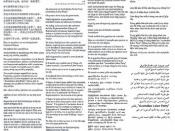1. The existing funding system for private schools
The Howard Government introduced the existing funding system for private schools in 2001 during an intense debate. The current funding system works under the Howard Government's socio-economic status (SES) model, which measures the socio-economic status of children's parents based on their postcode instead of asking each parent questions about their income. The socio-economic status refers to the parent's ability to financially support their school.
Each private school is given a SES score, which ranges from 70 to 135. Schools with students coming from predominantly high socio-economic areas will get a higher score and less funding. The aim of this system is to allocate funding on a 'needs' basis. For non-government schools, most government funding is received directly from the Commonwealth.
2. Major criticism of the existing funding system
The major criticism of this funding method is that the system does not take into account a school's private earnings (eg: fees).
As a result of this, the overall trend has been to give the biggest increases to the schools that are obviously amongst the wealthiest.
While under the old ERI system (which measured the school's wealth and schools were put into 12 categories with Category 1 being the 'wealthiest') there were some anomalies and problems, the new system is criticised as being 'unfair, and awarding the largest increases to the schools that least need them".
In the AEU Federal Election Fact Sheet (issued April 2004) it shows the 50 schools that received the biggest increases (up to 300% increase). Of the 50 schools which received the highest increases, only one was not previously in Categories 1 - 3. "No one can justify a 200-300% funding increase for affluent schools that have already got ahead of the national standard based on their private...



Private School Funding
When I was younger, both of my parents worked to put me through private school. They paid tuition, for books, for transportation and uniforms. There were NO government programs that contributed to the existance of the school, other than the donations through the church.
Now-a-days, the government is giving out vouchers to public school children, whose families cannot afford to send their children to private schools. And who pays for these vouchers? We of course, our tax dollars at work. And where does this money come from? Is it the tax money's we are paying for our own public schools; who by the way, are, for the most part, deep in debt.
There is suppose to be a seperation between church and state. It is time our government took public school funds and gave them directly to the public schools. They could then be better equipt to pay there bills in a timely manner and hire good decidated teachers.
If you want your child to attend a private school, get a job, second job and if need be, your child can pick up work during the summer months to help. It is time, we as a society, demand that our government be responsible for all the tax dollars they suck out of our wallets yearly.
0 out of 0 people found this comment useful.